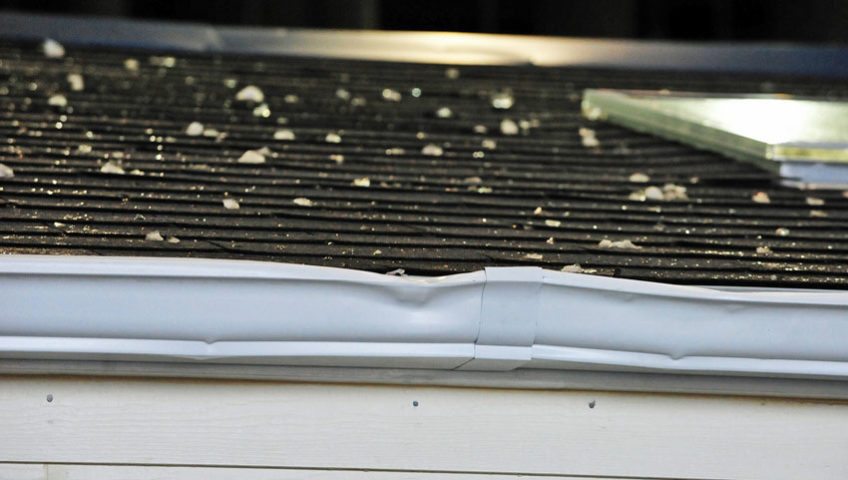It’s not uncommon for Georgia to be hit with some very severe storms with heavy winds, rain, and hail as part of the precipitation. When these storms make their visit, they leave whole swathes of destruction and property damage throughout.
Earlier this year, Metro Atlanta was afflicted with severe storms on March 20th. Haralson County and Fulton County faced the greatest impact, with over 29,000 people without power or electricity. Many trees fell and caused damage to the roofing of many of the homes in the area in the form of missing shingles, dented gutters, and broken ridge vents.
Last year, Hurricane Irma caused extensive damage throughout the Southeast. Even when it was downgraded to a tropical storm, the 65 mph winds still caused damage to many Georgia homes. A state of emergency was declared for 159 counties due to the heavy rain and wind posing a major threat. Is your home protected from storms, wind, and hail like you might think?
Even if your home doesn’t display visible signs of damage after such storms, there might still be some underlying damage you need to be aware of.
In this post, we’ll show you what you need to look for when assessing the damage of your roof. The information we provide will potentially help save you thousands of dollars long-term, so it’s very important you read each part carefully. You should keep a close eye on your roof whether a storm did pass your area recently or not.
However, severe storms exasperate any existing damage your home’s roof might have already had, which is why we strongly advise you to check to see if your roof has suffered from damage.
1. Missing Shingles
Any home is vulnerable to the high-speed winds a storm brings. The winds are powerful enough to remove shingles from your roof and expose the underlayment and roof deck to more damage. The shingles of your roof have sealants and adhesive strips and normally are resistant to water and wind damage.
However, these may wear overtime and buckle under pressure from the intensity of the winds. Another problem your roof can have is with the nails attaching the shingles, which can also loosen and be blown off by wind.
2. Bent Gutters
Your gutters are just as vulnerable to severe storm damage as your roof. The heavy rain from a storm quickly carries debris and dirt, which builds up and clogs your gutters. When the gutters are clogged, water can no longer travel efficiently away from the roof. As a result, there is a lot of stress and pressure on the gutter.
Left unchecked, the gutter will sag and break apart entirely from your home, so it’s essential to contact a professional roofing contractor when you see this problem.
3. Ridge Vent Dents
Watch for dents in the ridge vents, the structures in your home which keep your whole roof deck cooled and keep your roof lasting longer. These dents could be caused by poor installation worsened by the impact of a severe storm. Ridge vents that are dented are less effective in keeping water out of your home and will cause leaks.
4. Missing Ridge Caps
Roof caps cover the parts of the roof where the angles meet and play an important role in stopping rain and snow from leaking into your home. They are also one of the most vulnerable parts of your roof, so immediately check this part of your roof after a storm. You should also check your ridge caps at least once a year as part of your roofing maintenance.
5. Decaying Soffits and Fascia
Soffits and fascia are the overhangs of your roof and are often the first parts of your roof to succumb to rotting. This problem is made worse after a storm causes damage to your home. Excess water seeping through the soffits and fascia creates the perfect breeding ground for bacteria, mold, and fungi to form.
Pests such as bees, birds, squirrels, and hornets will make themselves at home under the eaves and cause more damage.
6. Separation of Flashing
This is the kind of damage you might not be able to see readily and will need the advice of a professional roofing contractor in Metro Atlanta to spot for you. After a storm, the flashing around your chimney, walls, and edges of the roof can become separated, leaving your home prone to water damage and leaking.
7. Missing Granules
Another way to tell if a severe storm has caused damage to your home’s roofing system would be to check for missing granules. This problem especially affects asphalt shingles. Asphalt shingles with granule loss are more likely to deteriorate from the sun and excess water, so it’s best to have a professional roofing company replace them.
Areas Affected by the Storm in 2018
This year’s storm affected many cities in Georgia, including:
• Austell
• Douglasville
• Atlanta
• Alpharetta
• Johns Creek
• Sandy Springs
• Roswell
• College Park
• Hampton
• McDonough
• Stockbridge
• Dallas
• Braswell
• Hiram
• Duluth
• Norcross
• Peachtree Corners
• Suwanee
• Lawrenceville
Whether or not your city was impacted by this year’s weather, calling a professional roofing contractor is the best way to keep your roof in peak condition and catch problems before they grow worse.
Is It Time to Replace My Roof?
If you are unsure about whether your roof has suffered from storm damage, please give our roofing experts a call at 877-330-3301 and get a $500 credit towards your roof replacement. We’ll give you what you need to get ready for storms in the future and keep your roof protected and safe.


Recent Comments